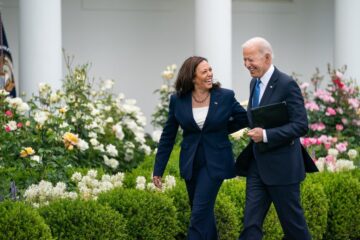Welcome back to Week 33 in my weekly reports analyzing the Covid-19 pandemic and its effects on the country and higher education, and happy Thanksgiving to all. For those of you reading this on my blog, Off the Silk Road, I have also launched a newsletter, where these reports can be sent directly to your email each week. Click here to subscribe.
Last week, we took stock of the national picture before Thanksgiving and discussed ways that college students can best stay safe around their families following their return home. This week, we will discuss what is in store for the country following Thanksgiving and briefly summarise colleges’ results from the fall.
A national look
We know the cycle: First the cases increase, then the hospitalizations, then the deaths. Since the end of October, we have seen cases climb to nearly 200,000 in one day. Now, we are facing record-high hospitalizations, with over 91,000 Americans currently in the hospital for Covid-19.
Let’s think about it this way: Since the spring surge (when testing was more limited) this disease has relentlessly killed around 1.8% of confirmed cases, with a 21-day lag. As the COVID Tracking Project’s Peter Walker notes, this means that the average daily death toll in about 3 weeks will get over 3,000 deaths per day, possibly even reaching 4,000 deaths per day. At our current trajectory (and this is excluding the impact of Thanksgiving), we are in for a devastating December.
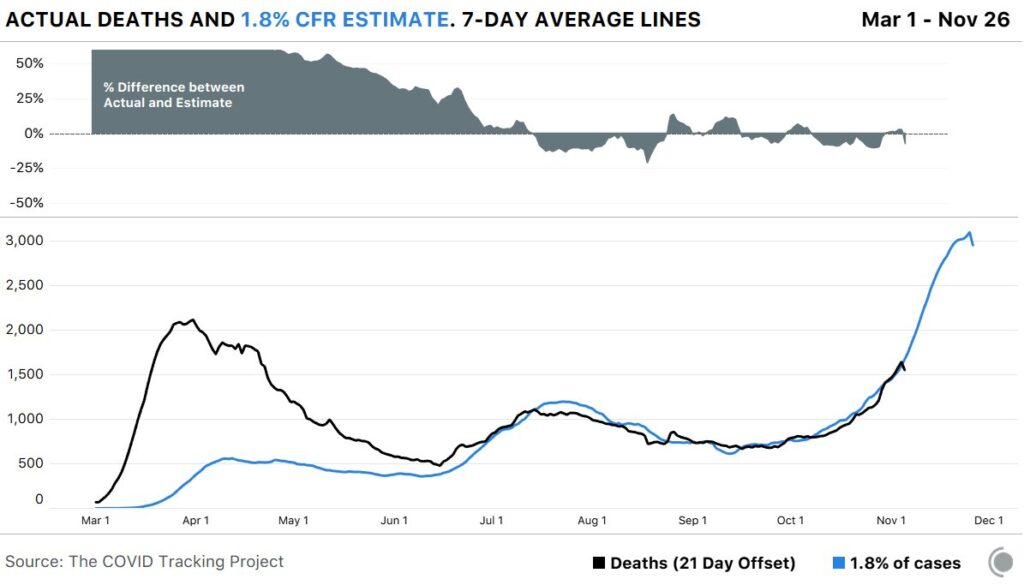
Reaching record-high hospitalizations could have an impact on the fatality rate; a shortage of nurses and other medical staff may cause more unnecessary deaths. As Stacker’s Betsy Ladyzhets points out, the number of new Covid-19 hospitalizations (a newly released number from HHS) exceeds 10,000 per day. Previously, we knew how many people are currently hospitalized for Covid-19; now we know how many people enter the hospital each day.
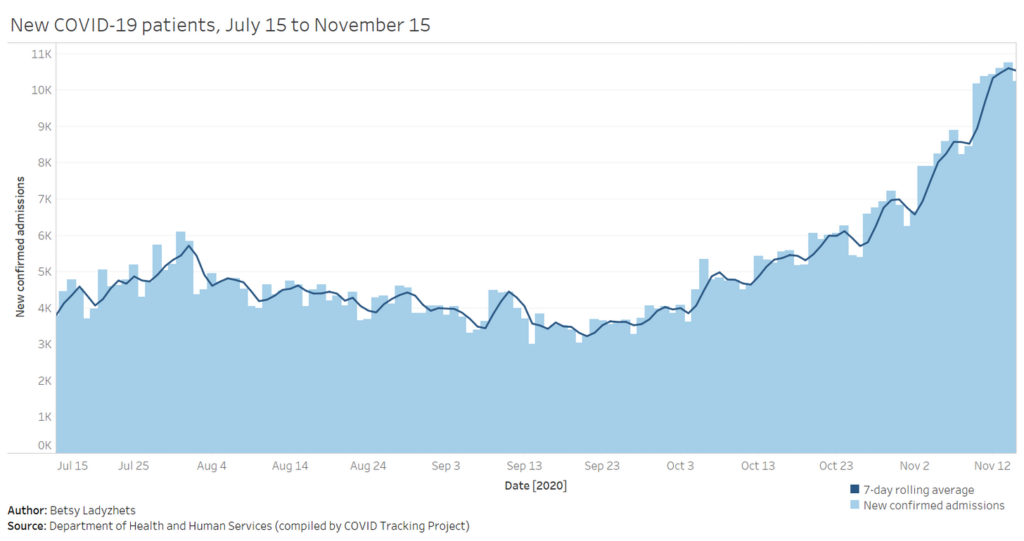
The situation is so dire in many hospitals around the country that the Minneapolis Star Tribune’s front page headline last week was “No beds anywhere.”
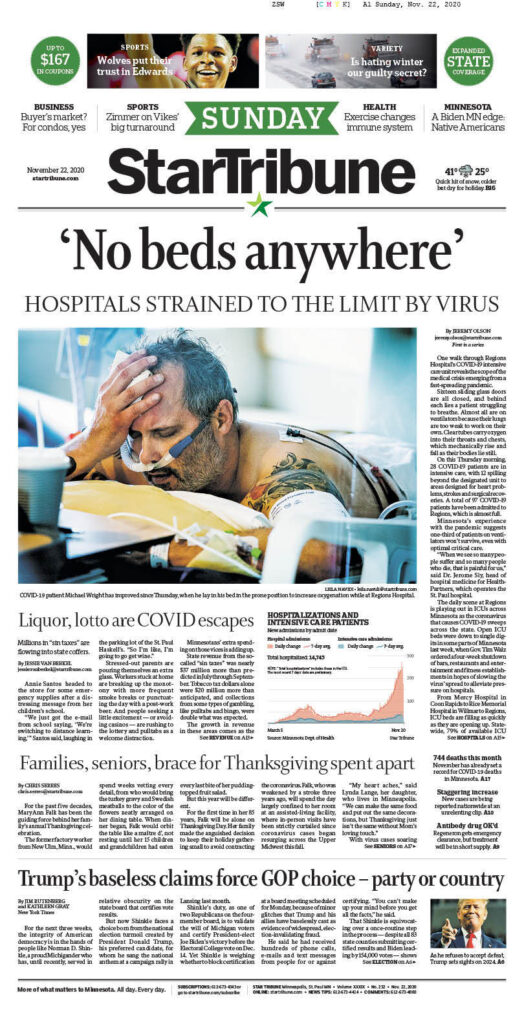
The virus is accelerating across our country, driven in part by small gatherings with family and friends where masking and social distancing norms are not followed. On average, 4% of the residents in counties across the country have been infected as recorded cases, with some approaching 20%. In Kearny County, KS, 1 in 12 have tested positive in the last 7 days. In Crowley County, CO, that number is 1 in 18.
In the lead-up to Thanksgiving, the TSA saw its highest passenger flows through airports since the start of the pandemic. This large-scale movement of people could undoubtedly cause more infections throughout the country. I find it useful to compare the Thanksgiving travel period to the Lunar New Year travel period in January, which had similar characteristics. One of the most effective policies China imposed during the typically busy Lunar New Year travel period was to waive all train (and many plane) ticket refund/change fees. This policy had two effects:
- It encouraged people to stay home
- For those who needed to travel, train cars were less dense, reducing the risk of infection
Instead, the U.S. saw tens of millions of Americans travel in advance of the holiday. While traffic on Thanksgiving day was around ⅓ of what it was last year, TSA data show over 6.5 million travelers were screened in the last 7 days. This mass movement of people could have been curtailed or restricted with effective policy. It was an avoidable tragedy and we did not have the federal foresight to implement a policy as simple as waiving change/refund fees.
Meanwhile, a New York Times survey found that only around 27% of Americans plan to dine with people outside their household, nationally, though this number varied by region. The statistic also may be an underestimate due to the lack of willingness among some Americans to respond truthfully to their Thanksgiving plans.
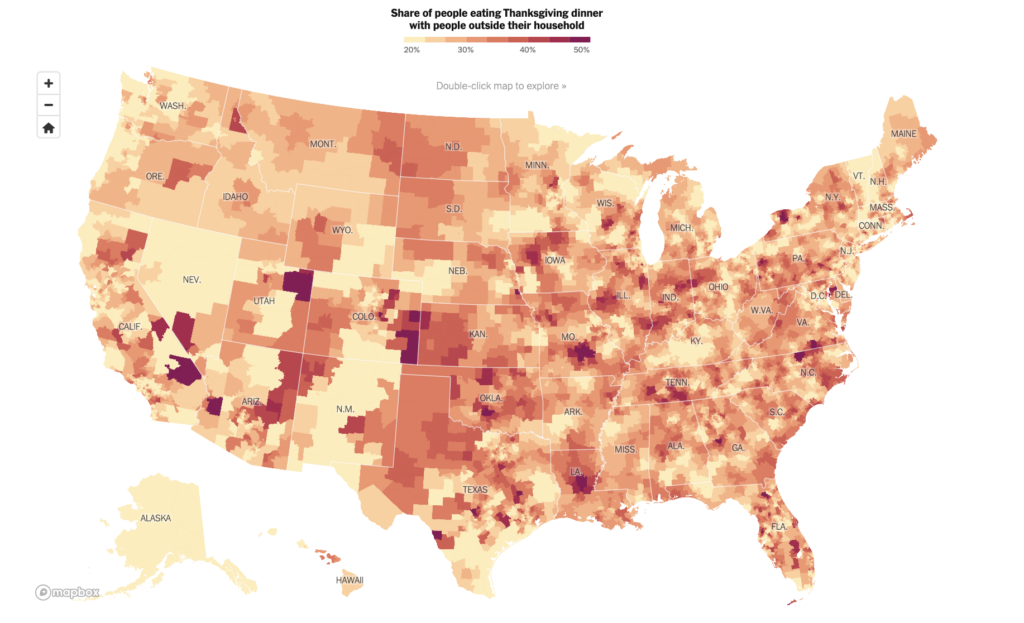
The coronavirus has also infected multiple members of Congress. New data from GovTrack show 34 members of Congress have contracted Covid-19 since March. This puts the congressional infection rate at 6.3%, higher than the U.S. infection rate of ~3.8% (based on the case count) or seroprevalence rate of ~10% (from recent studies). 76% of the members of Congress who have been infected are members of the House of Representatives. Another 20% are senators and one non-voting member has been infected. Republicans are infected 2.7x more than Democrats.
Testing supply and access has been an issue in this country since March, and parts of rural America still do not have testing sites. This map shows recent Covid-19 hotspots overlaid with testing sites. Many counties in Utah and other Midwestern states have one test site in the whole county. If we are to find a way out of this pandemic, we must lower the barriers to testing, through rapid tests and at-home varieties.
For the next few weeks, the country will wait to see the effects of the Thanksgiving surge. As editors at the COVID Tracking Project write, case counts will fluctuate in the coming days as states catch up from the holiday. Cases from Thanksgiving may appear next week or the week after, with hospitalizations and deaths to follow. Even without the Thanksgiving surge, the national picture is grim: ¼ of all Covid-19 cases have occurred in the last month, the CDC projects 321,000 deaths by December 19, and in nine states at least 1 in 1,000 people have died of coronavirus-linked causes.
Let’s take a look at some of the latest scientific developments:
- The CDC is considering shortening the recommended time for close contacts to quarantine from 14 days to a possible 7-10 with a test upon exit.
- In a survey of U.S. adults published in JAMA, 13.0% reported serious psychological distress in July 2020, relative to 14.2% in April 2020.
- New modeling from CDC researchers shows a possible regimen of travelling to minimize the risk of Covid-19 infection. To reduce the risk of introduction without extensive quarantine, optimal test timing after arrival is close to the time of arrival; with effective quarantine after arrival, testing a few days later optimizes sensitivity to detect those infected immediately before or while traveling.
- A study published in the Physics of Fluids showed that “the highly efficacious facemask, such as surgical masks with an estimated efficacy of around 70%, could lead to the eradication of the pandemic if at least 70% of the residents use such masks in public consistently.”
- Results of a clinical trial published in The New England Journal of Medicine found that no significant differences were observed in clinical status or overall mortality between patients treated with convalescent plasma and those who received placebo.
- It is shocking we are still talking about hydroxychloroquine when trial after trial has shown it has no effect, but a new trial found that postexposure therapy with hydroxychloroquine did not prevent SARS-CoV-2 infection or symptomatic Covid-19 in healthy persons exposed to a PCR-positive case patient. The incidence of adverse events was higher in the hydroxychloroquine group than in the usual-care group (56.1% vs. 5.9%), but no treatment-related serious adverse events were reported.
- A study published in Clinical Infectious Diseases estimated that 2.4 million hospitalizations, 44.8 million symptomatic illnesses, and 52.9 million total infections may have occurred in the U.S. population from February 27–September 30, 2020.
- According to a study published in Nature, there is no evidence for increased transmissibility from recurrent mutations in SARS-CoV-2.
- Drs. Michael Mina, Dan Larremore and other colleagues advocate for a national testing “regimen” to filter out infectious individuals. With multiple rapid tests per week, we can keep PCR for diagnosis and contain outbreaks.
- A new RT-LAMP test by researchers at CU-Boulder looks promising and requires little setup — perfect for schools and workplaces. Saliva is prepared in a solution and then changes color according to the result. Data show 94% sensitivity and >99% specificity.
Finally, some news on vaccines, some of which are on the horizon.
- Early data from AstraZeneca’s vaccine show that the vaccine was 70% effective on average. However, this is the result of two confusing dosing regimens, where one showed 62% efficacy and the other showed 90% efficacy. The company is likely to run another trial to clarify the results.
- As the CDC and FDA prepare to meet to discuss possible approvals for a vaccine and distribution protocol, United has begun to position flights to fly Pfizer’s vaccine.
- There are still many hurdles to full distribution of a vaccine, including access to rural America, possible side effects and the challenge of ensuring people return for a second dose.
- My colleague Dr. Jesse O’Shea wrote a brilliant thread on Twitter on combatting vaccine misinformation.
- In Thursday’s Brief-19 published by Dr. Jeremy Faust, I transcribed Dr. Natalie Dean’s explanation of vaccine efficacy vs. effectiveness. Clinical trial results and press releases point to vaccine efficacy — measurements made during a clinical trial. Vaccine effectiveness, on the other hand, describes how well the vaccine works in the real world. Based on previous vaccine trials, effectiveness may be somewhat lower than efficacy. Effectiveness is a broader term that defines how the vaccine performs in a population and includes “direct” and “indirect” effects.
As we look ahead to the future, getting through the winter is not the country’s only challenge. Baylor College of Medicine’s Dr. Peter Hotez writes about five main steps the Biden-Harris administration can take on the first day of office:
- Protecting homeland security
- CDC leading a federal response
- Fixing HHS agencies
- Vaccines
- Dismantling the anti-science empire
We must remember we are all in this together, and we must use all our individual and governmental tools to suppress the virus as we enter the winter. A piecemeal approach simply will not work.
Let’s move on to our discussion of higher education.
Higher education
Each Friday, I update the College Watchlist, which is currently tracking 150,054 total cases at 96 colleges across the country. At the top of my list of cases in the last 7 days are:
- Ohio State University – 514
- Penn State – 389
- University of Wisconsin – 266
- University of Minnesota – 262
- University of Missouri – 256
We had a paradox of reporting this week — many schools did not report due to the holiday, while others reported more cases than usual due to high cases found in exit testing. Here are the graphs for the sum and average of weekly cases throughout the semester.
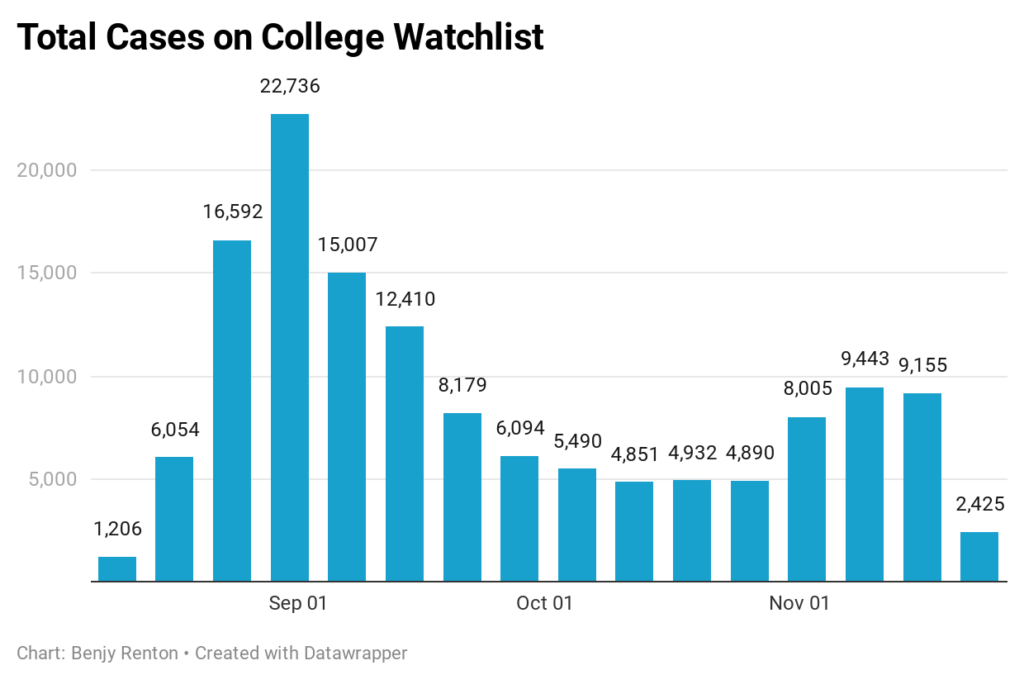
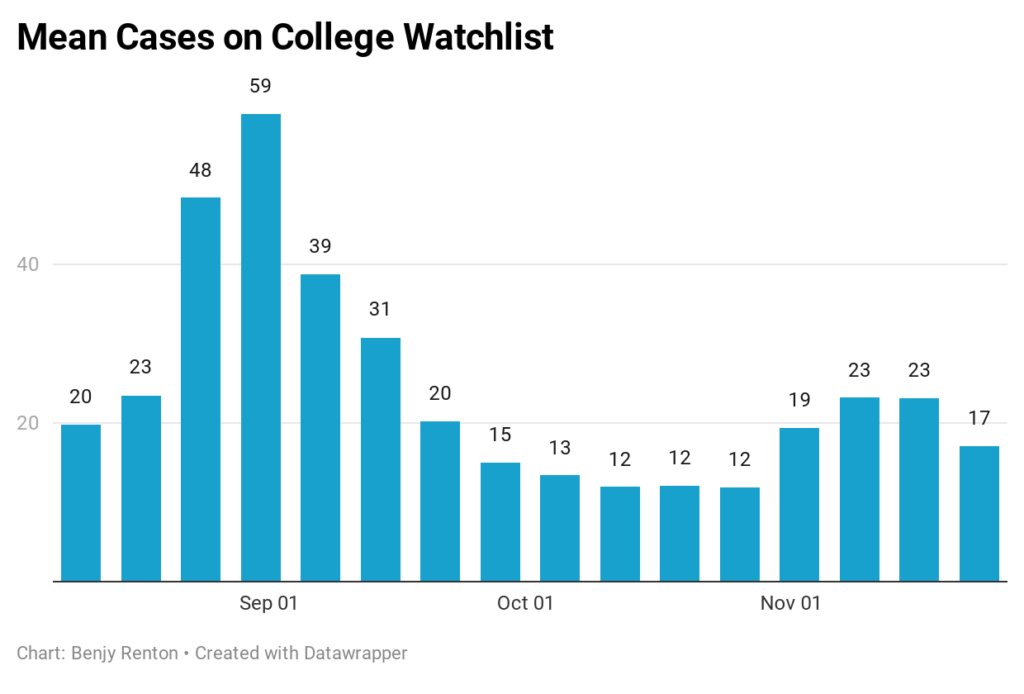
Throughout the summer and fall, we have been comparing cases on college campuses and the national picture to determine possible directions of transmission. We can see that cases spiked in colleges in September, and this new “wave” took around 1 week to reach campuses. Additionally, we may never know the impact of college students dispersing for Thanksgiving as the data are not sophisticated enough to track college students returning home. “Do I know how big it’s going to be?” Yale professor Dr. David Paltiel told The Chronicle of Higher Education’s Francie Diep about the effects of college students returning home for Thanksgiving. “I don’t know, but I do know that it has some of the classic earmarks of superspreading.”
Here’s a roundup of this week’s higher ed news:
- According to a Wall Street Journal report, most colleges did not conduct exit testing for students returning home for Thanksgiving.
- The Indiana Daily Student published a well-written investigation on the administrators behind their school’s coronavirus response.
- “That smell, the sulfuric gunpowder smell, is what I taste every time I eat,” one University of Florida student writes. “But I do have to ask: now that you know what happened to me, is it really worth it? Enjoy your turkey.”
- The University of Alabama is considering requiring all staff and students to return to campus in January, most of whom will not be tested on entry. [This is a disaster waiting to happen.]
- The Broad Institute in Massachusetts has conducted its 3 millionth test for New England colleges and universities.
- I discussed my home institution, Middlebury College’s, successes this fall in an interview with the Addison Independent.
- We have begun to see first reports of colleges’ plans for the spring.
- A new NBER paper shows a correlation between students living in two residence halls at UW-Madison and visitation to a 20-bar cluster and a group of 68 restaurants in the same area.
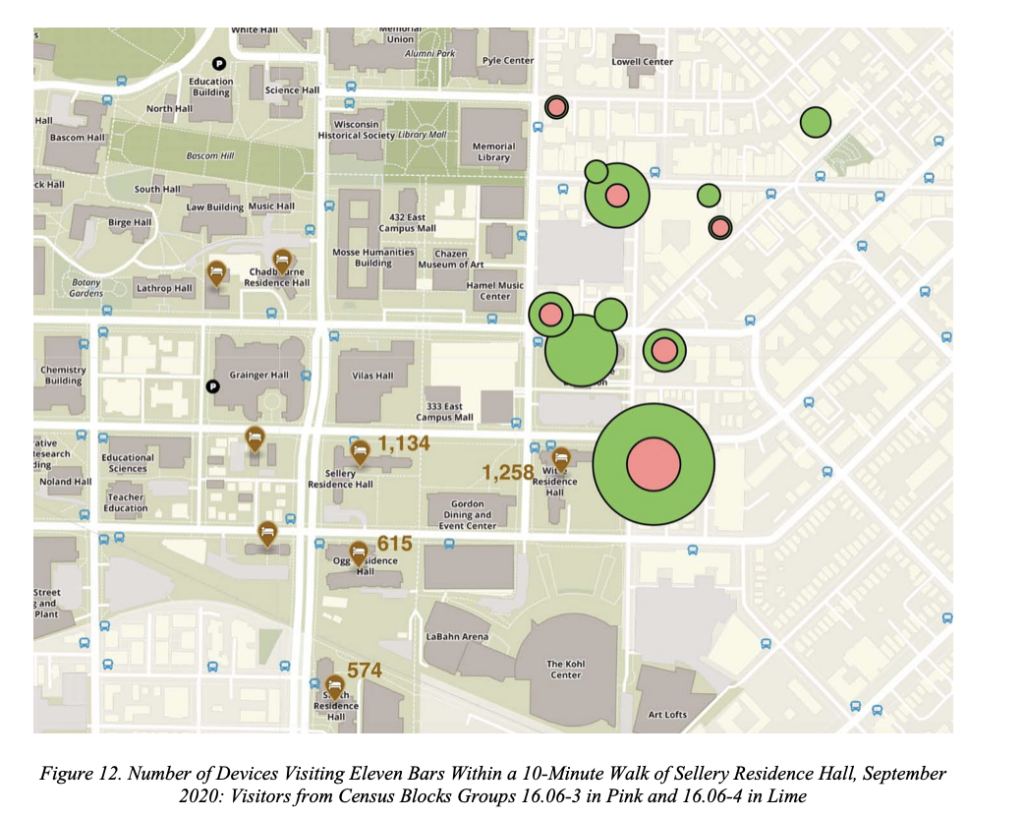
In the coming weeks, I will be providing more analysis into colleges’ results from the fall, as well as guidance for colleges in the spring.
The Good Stuff
Let’s roll the clips of the good stuff. In my usual tradition, I feature my favorite stories from the week. Here are my Top 12.
- The New York Times published a photo essay of a Thanksgiving like no other, with many Americans at home celebrating with their immediate families.
- Dr. Jessi Gold wrote a brilliant piece on the stresses young female scientific experts face during the pandemic.
- In a video from last year, Vice President-elect Kamala Harris discusses how to brine a turkey.
- College student-led mutual aid networks have raised tens of thousands of dollars to help peers cover basic costs of living.
- The two turkeys that President Trump pardoned, Corn and Cobb, spent one night in the Willard Hotel.
- World-renowned chef José Andrés has continued to feed millions of Americans amid the pandemic.
- Bloomberg reporter Jennifer Jacobs has established herself as the expert on the White House Covid-19 beat.
- A professor at the University of Iowa graciously offered to deliver meals to her students.
- The Washington Post’s Emily Davies reports on this year’s absence of “friendsgiving.”
- State poet laureates wrote in verse what they are thankful for this Thanksgiving.
- The pandemic has resulted in a decline in sales of scented candles as many people have lost their sense of smell.
- A Columbia University graduate became the first Latino DACA recipient to win a Rhodes Scholarship.
Conclusion
As we continue into the winter, America’s trajectory follows the worst of models. We will begin to see the results of an undeniable Thanksgiving surge, which will only exacerbate hospital capacity and cause more unnecessary deaths. With a vaccine on the horizon (possibly in a number of weeks), we must do all we can to protect our fellow citizens. It is likely that December will be the darkest month of the pandemic yet.
I’d like to thank all the student journalists with whom I have the pleasure of working. In the next weeks and months ahead, they will become vital in chronicling their colleges’ paths forward for the fall and beyond. Support their work by reading it.
My best to all for good health.
Like what you see? Don’t like what you see? Want to see more of something? Want to see less of something? Let me know in the comments. And don’t forget to subscribe to the weekly newsletter!
For more instant updates, follow me on Twitter @bhrenton.

